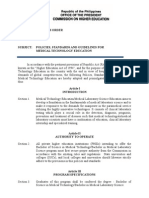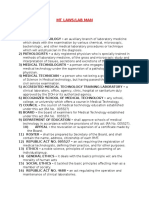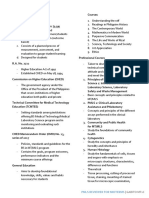PMLS 1 Module 11
PMLS 1 Module 11
Uploaded by
Chyle MaeCopyright:
Available Formats
PMLS 1 Module 11
PMLS 1 Module 11
Uploaded by
Chyle MaeOriginal Title
Copyright
Available Formats
Share this document
Did you find this document useful?
Is this content inappropriate?
Copyright:
Available Formats
PMLS 1 Module 11
PMLS 1 Module 11
Uploaded by
Chyle MaeCopyright:
Available Formats
5D
MLS 037 (Principles of Medical Laboratory
Science and Practice 1)
STUDENT ACTIVITY SHEET MEDICAL TECHNOLOGY / FIRST YEAR
Session # 11
LESSON TITLE: LABORATORY WASTE Materials:
MANAGEMENT
Book, pen and notebook, class list
LEARNING OUTCOMES:
References:
Upon completion of this lesson, the student can:
1. Republic of the Philippines, Department
1.Outline the appropriate safety measures that should be of Health (2011). Manual on healthcare
taken when handling laboratory waste waste management (3rd Ed.). Bldg. 4,
2. Classify different laboratory waste Department of Health, Tayuman St. cor. Rizal
3. Describe and demonstrate proper protocols when Avenue, Sta. Cruz, Manila, 1003 Philippines:
handling and disposing infectious, chemical, Department of Health – National Center for
pharmaceuticals and electronic waste. Health Facility Development (NCHFD).
2. Mcpherson,R.A. & Pincus,M.R. (2012)
Henry’s Clinical Diagnosis and Management
by Laboratory Metheds (22 nd Ed.)
Philadelphia: Elcevier Inc.
INTRODUCTION (5 minutes)
Firstly, the students are asked to read the topic which is found on page 10 to 14, Chapter 3: Healthcare
Waste from the reference book 1.
MAIN LESSON (13 minutes)
.
Students are asked to read the lesson ahead of time. Main reference of the lesson is found on Chapter 4:
Laboratory Safety of the reference book 1.
Lesson Outline:
A. What is Healthcare waste?
B. What are Healthcare facilities?
C. Categories of Healthcare waste
D. Labelling, Markings and Color-coding of plastic liners and Bins for proper waste segregation
Lesson Notes:
A. What is Healthcare Waste?
- Healthcare waste includes all forms of waste generated as a result of any of the following:
Diagnosis, treatment or immunization of human beings;
Research pertaining to the above activities;
Research using laboratory animals for the improvement of human health;
Production or testing of biologicals; and
Other activities performed by Healthcare Facilities
B. What are Healthcare Facilities?
- Healthcare facilities are public private, and non-governmental institutions or facilities that contribute to
the improvement of the health status of an individual.
- Includes:
This document and the information thereon is the property of PHINMA
Education (College of Medical Technology) 1 of 10
Hospitals and medical centers
Clinics and healthcare units related to patient care
Rehabilitation centers, hospices, psychiatric centers, and centers providing long-term healthcare
services
Related laboratories and research centers
Ambulance and emergency care mobiles
Teaching and training hospitals and medical schools
C. Categories of Healthcare Waste
1. Infectious waste
- All waste suspected to contain pathogens (or their toxins) in sufficient concentration to cause
diseases to a potential host
- Discarded materials or equipment used for diagnosis, treatment and prevention of disease of
patients with infectious disease
- Highly infectious waste includes microbial cultures and stocks of highly infectious agents from
Medical Analysis Laboratories and biofluids from patients with highly infectious disease (require
disinfection at source)
2. Sharps
- Items that can cause cuts or puncture wounds
- Used or expired sharps e.g., hypodermic intravenous or other needles; auto-disable syringes;
infusion sets; scalpels; pipets; broken glass; wet ampules
- Does not include syringes and needles used for antineoplastic purposes.
3. Pathological and Anatomical Waste
- Refers to tissue sections and body material derived from biopsies or surgical procedures that
are then examined in the laboratory
- Anatomical waste is a subgroup of pathological waste that refers to recognizable body parts
such as amputated limbs and the like.
4. Pharmaceutical waste
- Refers to expired, split and contaminated pharmaceutical products, drugs and vaccines; as well
as discarded items used in handling pharmaceuticals
- Pharmaceutical wastes include antineoplastic, cytotoxic, and genotoxic waste
- Drugs usually used in oncology (antineoplastic drugs) or radiotherapy units have a high
hazardous mutagenic or cytotoxic effect.
5. Chemical Waste
- Refers to discarded chemicals (solid, liquid, or gaseous) generated during disinfecting and
sterilizing procedures.
- Chemical wastes can be further classified into corrosive, reactive, toxic and flammable.
- Chemical waste also include waste with high content of heavy metals and their derivatives.
6. Radioactive Waste
- Wastes exposed to radionuclide
- Resides from shipment of radioactive materials and unwanted solution of radionuclides intended
for diagnostic or therapeutic use
- Liquids, gas and solids contaminated with radionuclides whose ionizing radiations have
genotoxic effects
7. Non-Hazardous or General Waste
- Includes waste that has not been in contact with communicable or infectious agents, hazardous
chemicals or radioactive substances, and does not pose a hazard.
This document and the information thereon is the property of PHINMA
Education (College of Medical Technology) 2 of 10
D. Labelling, Markings and Color-coding of plastic liners and bins for proper waste segregation
Table 1: Infectious Waste
Table 2: Sharp Waste
This document and the information thereon is the property of PHINMA
Education (College of Medical Technology) 3 of 10
Table 3: Pathological and Anatomical Waste
Table 4: Pharmaceutical Waste
This document and the information thereon is the property of PHINMA
Education (College of Medical Technology) 4 of 10
Table 5: Chemical Waste
Table 6: Radioactive Waste
Table 7: Non-Hazardous or General Waste
This document and the information thereon is the property of PHINMA
Education (College of Medical Technology) 5 of 10
FOR UNDERSTANDING (25 minutes)
-After reading the lesson notes ahead of time students are asked to answer the following activities:
ACTIVITY 1
1. In your own words, compare Pathological waste from Anatomical waste.
________________________________________________________________________________________
________________________________________________________________________________________
________________________________________________________________________________________
___________________________
2. Tabulate the categories of Healthcare waste based on Plastic liners and Bins:
CATEGORY PLASTIC LINERS BINS
MARKINGS SPECIFICATION MARKINGS SPECIFICATION
AND AND
LABELLING LABELLING
1. INFECTIOUS WAST
2. SHARPS
3. PATHOLOGICAL AND
ANATOMICAL WASTE
4. PHARMACEUTICAL WASTE
5. CHEMICAL WASTE
This document and the information thereon is the property of PHINMA
Education (College of Medical Technology) 6 of 10
6. RADIOACTIVE WASTE
7. NON-HAZARDOUS OR
GENERAL WASTE
ACTIVITY 2
DIRECTIONS: Choose the best answer. Write the letter beside the number.
1. All of the following are healthcare facility, except:
a. Rehabilitation centers
b. Research centers
c. Medical Schools
d. NOTA
2. All of the following are considered a sharp waste, except:
a. antineoplastic needles
b. Broken glass
c. Lancets
d. Syringes
3. All of the following are not false about Infectious waste, except:
a. Yellow plastic than can withstand autoclaving
b. Plastic liners are not applicable
c. Strong leak proof bin with cover
d. Plastic liners should be 0.009 mm thick
4. Yellow with black band
a. Infectious waste
b. Chemical waste
c. Pharmaceutical waste
d. Sharps
5. It includes waste that has not been in contact with communicable or infectious agents, hazardous cehmicals
or radioactive substances and does not pose a hazard.
a. General waste
b. Non-hazardous waste
c. Two of these
d. None of these
6. Orange liners
a. Radioactive waste
b. Infectious waste
c. Chemical waste
d. General waste
This document and the information thereon is the property of PHINMA
Education (College of Medical Technology) 7 of 10
7. All of the following belongs to Pharmaceutical waste, except:
a. Cytotoxic waste
b. Genotoxic waste
c. Antineoplastic waste
d. Body fluids
8. Waste exposed to radionuclide
a. Infectious waste
b. Radioactive waste
c. Chemical waste
d. General waste
9. Bins with recycle symbol:
a. General waste
b. Chemical waste
c. Infectious waste
d. Sharps
10. Refers to expired, split and contaminated pharmaceutical products, drugs and vaccines.
a. Infectious waste
b. Pharmaceutical waste
c. General waste
d. Radioactive waste
11. Disposable bottle that is made of amber colored glass, with at least 4L capacity that is strong, chemical
resistant and leaf proof.
a. Infectious waste
b. Chemical waste
c. Pharmaceutical waste
d. Radioactive waste
12. All of the following are true about Chemical waste bins, except:
a. Amber colored glass
b. At least 4L capacity
c. Chemical resistant
d. NOTA
13. For cytotoxic, genotoxic and antineoplastic waste:
a. Pharmaceutical waste
b. Cytotoxic waste
c. Chemical waste
d. General waste
14. All of the following are true about radioactive waste bins, except:
a. Radiation proof repositories
b. lead-lined
c. leak proof
d. 0.009 mm thick
15. Yellow with black band:
a. Pharmaceutical waste
b. Infectious waste
c. Radioactive waste
d. General waste
16. Black or colorless:
a. Biodegradable
b. Non-biodegradable
c. Recyclable
d. Reusable
17. Green:
a. Biodegradable
b. Non-biodegradable
This document and the information thereon is the property of PHINMA
Education (College of Medical Technology) 8 of 10
c. Recyclable
d. Reusable
18. Refers to recognizable human body parts.
a. Pathological waste
b. Anatomical waste
c. General waste
d. Infectious waste
19. All of the following are healthcare waste, except
a. Infectious waste
b. Chemical waste
c. General waste
d. NOTA
20. In what healthcare waste does a broken glass belong?
a. Infectious waste
b. Sharps
c. General waste
d. Chemical waste
This document and the information thereon is the property of PHINMA
Education (College of Medical Technology) 9 of 10
LESSON WRAP-UP (10 minutes)
A. Work Tracker
Mark (encircle) the session you have finished today in the tracker below. This is simply a visual to help you
track how much work you have accomplished and how much work there is left to do.
You are done with the session! Let’s track your progress.
B. Think About Your Learning
Let’s check your learning experience! Answer the following below.
1. Which part of the lesson is the most difficult?
________________________________________________________________________________________
________________________________________________________________________________________
________________________________________________________________________________________
___________________________
2. Which part of the lesson you did well?
________________________________________________________________________________________
________________________________________________________________________________________
________________________________________________________________________________________
___________________________
(For next session, review on page 16 to 47, Chapter 4: Healthcare Waste Minimization, Chapter 5:
Waste Handling, Collection, Storage, and Transport, and Chapter 6: Waste Treatment and Disposal
System from the reference book 1.)
This document and the information thereon is the property of PHINMA
Education (College of Medical Technology) 10 of 10
You might also like
- HUMHST1Document204 pagesHUMHST1Shekinah CamachoNo ratings yet
- CMO14 3mt01Document75 pagesCMO14 3mt01makike100% (2)
- PMLS His Reviewer Midterms Lessons 1Document14 pagesPMLS His Reviewer Midterms Lessons 1Mark vincent EspinosaNo ratings yet
- Basic Concepts On Laboratory Biosafety and BiosecurityDocument27 pagesBasic Concepts On Laboratory Biosafety and BiosecurityAlmay Minka GamayonNo ratings yet
- Defining The Practice of Medical Technology or Clinical Laboratory Science ProfessionDocument27 pagesDefining The Practice of Medical Technology or Clinical Laboratory Science ProfessionKianna TicsayNo ratings yet
- Module # 2 Medical Terminologies and Abbreviations and Ethics in The ProfessionDocument6 pagesModule # 2 Medical Terminologies and Abbreviations and Ethics in The ProfessionJonice NavarroNo ratings yet
- PMLS Lesson 7Document2 pagesPMLS Lesson 7Althea EspirituNo ratings yet
- 11 - HCWMDocument7 pages11 - HCWMGrace FloresNo ratings yet
- Clinical Chemistry I, Syllabus PDFDocument6 pagesClinical Chemistry I, Syllabus PDFAbd ahmad100% (1)
- Introduction To MLS 1Document11 pagesIntroduction To MLS 1Thea sam penafloridaNo ratings yet
- Experiment 1 - Differential Count ImportanceDocument5 pagesExperiment 1 - Differential Count ImportanceIra ReyNo ratings yet
- History of Medical Technology ProfessionDocument12 pagesHistory of Medical Technology ProfessionGeneva ApeladoNo ratings yet
- MT Laws and Lab ManDocument8 pagesMT Laws and Lab ManGene Narune GaronitaNo ratings yet
- Special Collections and Point of Care TestingDocument42 pagesSpecial Collections and Point of Care Testingmicah cajandabNo ratings yet
- PMLS 2 Unit 5 Venipuncture ProcedureDocument91 pagesPMLS 2 Unit 5 Venipuncture ProcedureYlyza MarquezNo ratings yet
- PRC Tos Board ExamDocument10 pagesPRC Tos Board Examapi-291835787No ratings yet
- Medical Technology (MT) Laws: A. Basic ConceptsDocument19 pagesMedical Technology (MT) Laws: A. Basic ConceptsK-idol LiveNo ratings yet
- 5527 and AmendmentsDocument18 pages5527 and AmendmentsMica BernardoNo ratings yet
- Principles of Medical Technology Practice 1Document6 pagesPrinciples of Medical Technology Practice 1Maw BerryNo ratings yet
- PMLS 1Document14 pagesPMLS 1AelwenNo ratings yet
- 6 Ra 1517Document56 pages6 Ra 1517Jay Andrea Vea Dayuday-IsraelNo ratings yet
- Manglo - Prelims Reviewer in Medtech LawsDocument24 pagesManglo - Prelims Reviewer in Medtech LawsRhaine Alyssa MangloNo ratings yet
- Chapter 3 MTLBEDocument47 pagesChapter 3 MTLBEJohn Niño TorresNo ratings yet
- PMLS Lesson 5Document7 pagesPMLS Lesson 5Althea EspirituNo ratings yet
- Antihuman GlobulinDocument18 pagesAntihuman GlobulinChariss Pacaldo ParungaoNo ratings yet
- Jaycommss Principles of Medical Laboratory Science Practice 1Document73 pagesJaycommss Principles of Medical Laboratory Science Practice 1Ces GarciaNo ratings yet
- PMLS Semi Finals Law NotesDocument5 pagesPMLS Semi Finals Law NotesChriszel Mae Gamueda100% (1)
- Clinical Microscopy 1 Test Review and Case Studies Jethro Rada JRDocument34 pagesClinical Microscopy 1 Test Review and Case Studies Jethro Rada JRAlex LiganNo ratings yet
- Alinsunurin - PMLS2 - Prelim ExamDocument10 pagesAlinsunurin - PMLS2 - Prelim ExamFrankenstein MelancholyNo ratings yet
- Kami Export - LECTURE - Nature of The Clinical Laboratory PDFDocument21 pagesKami Export - LECTURE - Nature of The Clinical Laboratory PDFnicoNo ratings yet
- Medical Technology Board Exams (Syllabus)Document6 pagesMedical Technology Board Exams (Syllabus)RJ Claude Mercadejas NionesNo ratings yet
- Pmls 1: MT TermDocument4 pagesPmls 1: MT TermSamantha Louise CondinoNo ratings yet
- AUBF Lec - Lab Safety - QADocument12 pagesAUBF Lec - Lab Safety - QALeinard ClaveroNo ratings yet
- Lesson 10 - Continuing Professional DevelopmentDocument3 pagesLesson 10 - Continuing Professional DevelopmentCookie MonsterNo ratings yet
- Medical Microbiology (Mmic 201) : Prepared byDocument35 pagesMedical Microbiology (Mmic 201) : Prepared byalok1503No ratings yet
- Assignment 1: HistopathologyDocument2 pagesAssignment 1: Histopathologyskeltenboi100% (3)
- Buenviaje-HEAT AND ACETIC ACID TESTDocument7 pagesBuenviaje-HEAT AND ACETIC ACID TESTrio salvadorNo ratings yet
- Chapter 04: Laboratory Safety Test Bank: 1. A. B. C. D. Ans: ADocument7 pagesChapter 04: Laboratory Safety Test Bank: 1. A. B. C. D. Ans: AroeNo ratings yet
- HTMLE SEMINAR NOTES DOC. ORTEGA - CompressedDocument35 pagesHTMLE SEMINAR NOTES DOC. ORTEGA - CompressedNISSI JUNE T. UNGABNo ratings yet
- PMLS L9 Professional OrganizationsDocument4 pagesPMLS L9 Professional OrganizationsJerica Basco LayosNo ratings yet
- Differential CountDocument7 pagesDifferential CountMohsen HaleemNo ratings yet
- St. Alexius College, Inc.: Clinic Chemistry 2 Laboratory ManualDocument90 pagesSt. Alexius College, Inc.: Clinic Chemistry 2 Laboratory ManualFay SNo ratings yet
- PMLS 2 Unit 8 Special Collection Point of Care TestingDocument91 pagesPMLS 2 Unit 8 Special Collection Point of Care TestingYlyza MarquezNo ratings yet
- Final Histopath Notes.Document19 pagesFinal Histopath Notes.anneorigmtNo ratings yet
- Bone Marrow Film Examination For Platelet Maturation Series: Activity No. 1Document43 pagesBone Marrow Film Examination For Platelet Maturation Series: Activity No. 1pixiedustNo ratings yet
- Doliente Activity 7 EpidemiologyDocument7 pagesDoliente Activity 7 EpidemiologyKristel Doliente100% (1)
- CC Partii&III NotesDocument30 pagesCC Partii&III NotesAnielle Mongaya100% (1)
- PMLS Lab and Lec ReviewerDocument19 pagesPMLS Lab and Lec ReviewerRenz Brixter Huyo100% (1)
- Lecture - 1 Hematological StainingDocument20 pagesLecture - 1 Hematological StainingOjambo FlaviaNo ratings yet
- 1 CCHM Trans LecDocument5 pages1 CCHM Trans LecCRUZ, ANNA MARIELLENo ratings yet
- BiochemistryDocument35 pagesBiochemistryGølà Sèèñàà–baale irraaNo ratings yet
- Table of Test Specifications and Sample Questions For Ana/Physio - Anatomy and PhysiologyDocument10 pagesTable of Test Specifications and Sample Questions For Ana/Physio - Anatomy and PhysiologyAileen SalcedaNo ratings yet
- Act.1 RQ 2 Pipettes and Others 1-3Document3 pagesAct.1 RQ 2 Pipettes and Others 1-3Francis Valdez100% (1)
- Histopath Lec - Week 2 - Topic 2Document3 pagesHistopath Lec - Week 2 - Topic 2Juren LasagaNo ratings yet
- BS in Medical Technology ProgramDocument5 pagesBS in Medical Technology ProgramDianne Crystal G. CruzNo ratings yet
- Lab Activity No. 1 - Hemoglobin DeterminationDocument2 pagesLab Activity No. 1 - Hemoglobin DeterminationChelsea Padilla Delos ReyesNo ratings yet
- Introduction To UrinalysisDocument28 pagesIntroduction To UrinalysisNicnoc RiveraNo ratings yet
- Micropara Final LabNotesDocument75 pagesMicropara Final LabNotescream oNo ratings yet
- 1 Hema LecDocument5 pages1 Hema LecAngela ReyesNo ratings yet
- The politics of hunger: Protest, poverty and policy in England, <i>c.</i> 1750–<i>c.</i> 1840From EverandThe politics of hunger: Protest, poverty and policy in England, <i>c.</i> 1750–<i>c.</i> 1840No ratings yet



























































